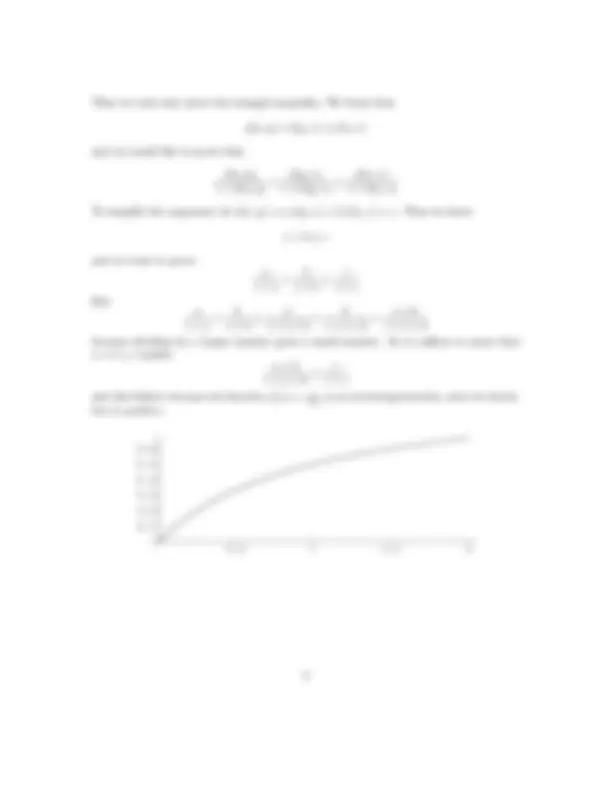



Study with the several resources on Docsity

Earn points by helping other students or get them with a premium plan


Prepare for your exams
Study with the several resources on Docsity

Earn points to download
Earn points by helping other students or get them with a premium plan
Community
Ask the community for help and clear up your study doubts
Discover the best universities in your country according to Docsity users
Free resources
Download our free guides on studying techniques, anxiety management strategies, and thesis advice from Docsity tutors
Material Type: Assignment; Class: Intro to Topology; Subject: Mathematics; University: University of Oregon; Term: Unknown 1989;
Typology: Assignments
1 / 3

This page cannot be seen from the preview
Don't miss anything!


1.2: The triangle inequality must hold for every choice of a, b, and c. For instance, it must hold if a = b, so d(a, b) + d(a, c) ≥ d(b, c)
becomes d(b, b) + d(b, c) ≥ d(b, c)
Now d(b, b) = 0 by axiom one, so this gives d(b, c) ≥ d(b, c), which is obvious. You cannot win every time.
The remaining special cases give something interesting. Suppose we set b equal to c. Then the triangle inequality becomes
d(a, c) + d(a, c) ≥ d(c, c)
Since d(c, c) = 0, this gives 2d(a, c) ≥ 0 and so d(a, c) ≥ 0. Since a and c are arbitrary, we have proved that the distance between any two points is ≥ 0, as required.
Finally set a = c. The triangle inequality becomes
d(c, b) + d(c, c) ≥ d(b, c)
Since d(c, c) = 0, we have d(c, b) ≥ d(b, c). This holds for any b and c, so interchanging b and c gives t d(b, c) ≥ d(c, b) and thus d(b, c) = d(c, b) as required.
1.3a: Let d(x, y) = ||x−y||. Then d(x, x) =
(xi − xi)^2
= 0, as required. Conversely,
if d(x, y) = 0, then
(xi − yi)^2
= 0. Squaring,
(xi − yi)^2 = 0. Each term in this expression is non-negative, so the expression can only be zero if each xi − yi = 0 and thus only if x = y.
We must prove the triangle inequality. Since d(a, b) = d(b, a) by the first exercise, we can write the triangle inequality in its more standard form d(x, z) ≤ d(x, y) + d(y, z). Thus we must prove that ||x − z|| ≤ ||x − y|| + ||y − z||
But it is known that ||a + b|| ≤ ||a|| + ||b||. Apply this when a = x − y and b = y − z to get ||x − z|| ≤ ||x − y|| + ||y − z||.
Finally, the graduate students need to prove that ||a + b|| ≤ ||a|| + ||b||. First we prove the Schwarz inequality | < x, y > | ≤ ||x||||y||.
Indeed (^) 〈 x −
< x, y > ||y||^2
y, x −
< x, y > ||y||^2
y
because the length of any vector is non-negative. Expanding
〈 x, x
< x, y >^2 ||y||^2
and so (^) 〈
x, x
y, y
x, y
Since < x, x >= ||x||^2 , the Schwarz inequality follows by taking square roots.
But then ||a + b||^2 =< a + b, a + b >=< a, a > +2 < a, b > + < b, b >
and by the Schwarz inequality this is less than or equal to
< a, a > +2||a|| ||b||+ < b, b >= ||a||^2 + 2||a|| ||b|| + ||b||^2 =
||a|| + ||b||
The required inequality follows by taking square roots.
1.3a continued: Similar arguments hold for d(x, y) =
|xi − yi|. This expression is clearly zero if x = y. Conversely if it is zero, then each term of the sum must be zero, so xi = yi for all i, so x = y.
According to the triangle inequality for ordinary real numbers, |a + b| ≤ |a| + |b|. Set a = xi − yi and b = yi − zi to obtain |xi − zi| ≤ |xi − yi| + |yi − zi|. Summing
∑ |xi − zi| ≤
|xi − yi| +
|yi − zi|
so d(x, z) ≤ d(x, y) + d(y, z).
1.3b: If d(x, y) = (x − y)^2 , the triangle inequality fails. For example, let x = 0, y = 1, z = 2. Then d(x, y) + d(y, z) = 1^2 + 1^2 = 2, but d(x, z) = 2^2 = 4, so it is not true that d(x, z) ≤ d(x, y) + d(y, z).
1.3e: In the exercise set for next week, we will show that the open sets using d and the open sets using d′^ are the same. So the metric spaces using d and using d′^ are homeomorphic. Notice that every subset in the metric space using d′^ is bounded because d′^ < 1. So the condition that a metric space is bounded is not topologically interesting; we can replace any metric space by a homeomorphic one in which every subset is bounded.
Clearly d′(x, y) = 0 if and only if d(x, y) = 0, and so if and only if x = y.